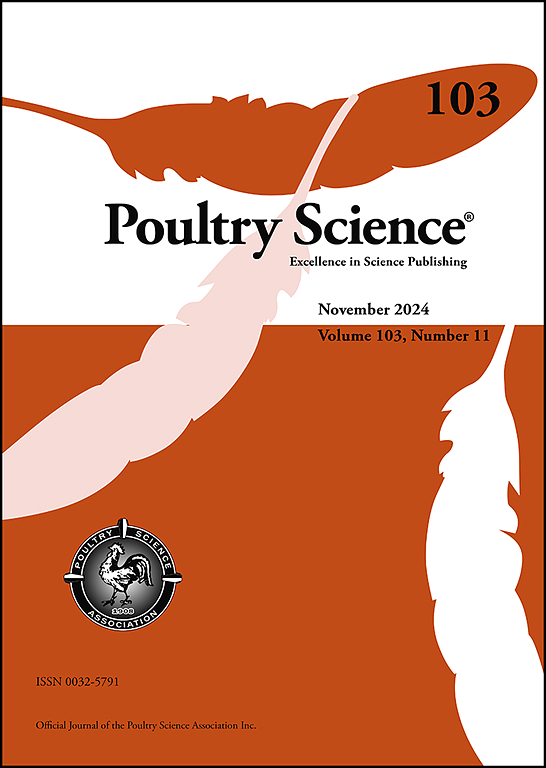Trans-cinnamaldehyde nanoemulsion reduces Salmonella Enteritidis biofilm on steel and plastic surfaces and downregulates expression of biofilm associated genes
IF 3.8
1区 农林科学
Q1 AGRICULTURE, DAIRY & ANIMAL SCIENCE
引用次数: 0
Abstract
Salmonella Enteritidis is a major poultry-associated foodborne pathogen that can form sanitizer-tolerant biofilms on various surfaces. The biofilm-forming capability of S. Enteritidis facilitates its survival on farm and food processing equipment. Conventional sanitization methods are not completely effective in killing S. Enteritidis biofilms. This study investigated the efficacy of a Generally Recognized as Safe phytochemical Trans-cinnamaldehyde (TC), and in its nanoemulsion form (TCNE), for inhibiting S. Enteritidis biofilm formation and inactivating mature biofilms developed on polystyrene and stainless-steel surfaces. Moreover, the effect of TC on Salmonella genes critical for biofilm formation was studied.
TCNE was prepared using a high energy sonication method with Tween 80. For biofilm inhibition assay, S. Enteritidis was allowed to form biofilms either in the presence or absence of sub-inhibitory concentration (SIC; 0.01 %) of TCNE at 25°C and the biofilm formed was quantified at 24-h intervals for 48 h. For the inactivation assay, S. Enteritidis biofilms developed at 25°C for 48 h were exposed to TCNE (0.5, 1 %) for 1, 5, and 15 min, and surviving S. Enteritidis in the biofilm were enumerated. SIC of TCNE inhibited S. Enteritidis biofilm by 45 % on polystyrene and 75 % on steel surface after 48 h at 25°C compared to control (P < 0.05). All TCNE treatments rapidly inactivated S. Enteritidis mature biofilm on polystyrene and steel surfaces (P < 0.05). The lower concentration of TCNE (0.5 %) reduced S. Enteritidis counts by 1.5 log CFU/ml as early as 1 min of exposure on both polystyrene and stainless-steel surfaces. After 15 min of exposure, TCNE at concentration of 0.5 or 1 % reduced S. Enteritidis count significantly by 4.5 log CFU or 6 log CFU/ml on polystyrene or stainless-steel surfaces. TC downregulated the expression of S. Enteritidis genes (hilA, hilC, flhD, csgA, csgD, sdiA) responsible for biofilm formation (P < 0.05). Results suggest that TCNE has potential as a natural disinfectant for controlling S. Enteritidis biofilms on common farm and food processing surfaces, such as plastic and steel.
求助全文
约1分钟内获得全文
求助全文
来源期刊

Poultry Science
农林科学-奶制品与动物科学
CiteScore
7.60
自引率
15.90%
发文量
0
审稿时长
94 days
期刊介绍:
First self-published in 1921, Poultry Science is an internationally renowned monthly journal, known as the authoritative source for a broad range of poultry information and high-caliber research. The journal plays a pivotal role in the dissemination of preeminent poultry-related knowledge across all disciplines. As of January 2020, Poultry Science will become an Open Access journal with no subscription charges, meaning authors who publish here can make their research immediately, permanently, and freely accessible worldwide while retaining copyright to their work. Papers submitted for publication after October 1, 2019 will be published as Open Access papers.
An international journal, Poultry Science publishes original papers, research notes, symposium papers, and reviews of basic science as applied to poultry. This authoritative source of poultry information is consistently ranked by ISI Impact Factor as one of the top 10 agriculture, dairy and animal science journals to deliver high-caliber research. Currently it is the highest-ranked (by Impact Factor and Eigenfactor) journal dedicated to publishing poultry research. Subject areas include breeding, genetics, education, production, management, environment, health, behavior, welfare, immunology, molecular biology, metabolism, nutrition, physiology, reproduction, processing, and products.
 求助内容:
求助内容: 应助结果提醒方式:
应助结果提醒方式:


